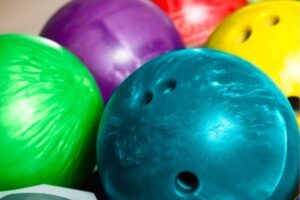While bowling may not be considered a physically demanding sport like basketball or soccer, those interested in the sport may wonder if it can still leave them feeling sore afterward.
In this article, we answer the question of whether bowling can cause muscle soreness and examine the factors that contribute to post-bowling discomfort. Understanding the potential effects on your body can help you prepare and recover more effectively.
Does Bowling Make You Sore?
Yes, bowling can indeed make you sore. Although it may not be as intense as high-impact sports, the repetitive motions involved in bowling can strain and fatigue certain muscles, leading to soreness. The primary areas that may be affected include the arm, shoulder, and leg muscles.
Repeatedly swinging the bowling ball and following through with the release can put stress on the arm and shoulder muscles.
Additionally, the physical act of walking, sliding, and stopping abruptly can engage the leg muscles, potentially causing soreness.
Factors such as the frequency of bowling, individual fitness levels, and proper warm-up and cool-down routines can all impact the level of soreness experienced after bowling.
It is essential to listen to your body, take breaks when needed, and engage in stretching exercises to minimize muscle soreness and promote recovery.
The Physical Demands Of Bowling
Bowling may not be the most physically demanding sport, but it still requires a certain level of physicality. Balance and stability are vital, as bowlers need to maintain a solid posture throughout their approach and release.
Coordination is another important aspect, as bowlers must synchronize their arm swing, footwork, and aim to achieve accuracy. While not overly strenuous, bowling does rely on upper body strength, especially when using heavier balls.
The repetitive motion of swinging the ball can strain the muscles in the arm, shoulder, and back.
Flexibility, particularly in the lower body, is necessary for a smooth slide during the approach.
Core stability plays a role in maintaining balance and transferring power from the body to the ball. Mental focus is also critical, as concentration, focus, and the ability to handle pressure contribute to consistent results.
Overall, while bowling may not be as physically demanding as some sports, it still requires a combination of physical skill, coordination, and mental focus to excel.
Is it normal to feel sore after bowling?
Yes, it is quite normal to feel sore after bowling, especially if you are not accustomed to the physical demands of the sport or if you have participated in an intense bowling session.
Bowling involves repetitive motions and engages various muscle groups, including the arms, shoulders, back, and legs. The act of swinging the ball, maintaining balance, and releasing it can put strain on these muscles.
Additionally, if you are using a heavier ball than what you are accustomed to or if you have been bowling for an extended period, it can further contribute to muscle fatigue and soreness.
The intensity of your bowling session, the number of games played, and the technique you use can also affect the level of soreness experienced.
To minimize soreness and reduce the risk of injury, it is advisable to warm up before bowling, stretch the muscles involved, and gradually increase the intensity and duration of your bowling sessions.
Adequate rest and recovery time between sessions can also help alleviate soreness.
If the soreness persists or is accompanied by severe pain, it is recommended to consult a healthcare professional for proper evaluation and guidance.

There are several factors that can contribute to post-bowling soreness:
1. Muscle Engagement: Bowling involves repetitive movements that engage various muscle groups, including the arms, shoulders, back, and legs. These muscles are used during the approach, swing, and release of the ball. The continuous contraction and extension of these muscles can lead to muscle fatigue and soreness.
2. Weight of the Ball: The weight of the bowling ball can also contribute to soreness. Heavier balls require more effort to swing and release, placing increased strain on the muscles involved. If you’re not accustomed to using a particular weight, it can lead to additional muscle soreness.
3. Technique and Form: Incorrect technique or form can put extra stress on certain muscles and joints, leading to soreness. For example, improper arm swing or excessive twisting of the body during release can strain the muscles and result in discomfort.
5. Lack of Conditioning: If you are not regularly engaged in physical activities or have not specifically trained for bowling, your muscles may not be accustomed to the demands of the sport. This lack of conditioning can contribute to increased post-bowling soreness.
6. Duration and Intensity: The duration and intensity of your bowling session can also affect soreness. Bowling for an extended period or participating in multiple games without proper rest can lead to muscle fatigue and increased soreness.
It’s important to remember that bowling is a physical activity that requires muscular effort and endurance. When you engage in a prolonged or intense bowling session, the muscles involved in the swinging motion, maintaining balance, and releasing the ball can become fatigued.
The level of soreness can vary from person to person, depending on their individual fitness level, technique, and the intensity of their bowling session.
Gradually increasing your bowling activity, taking breaks, and properly caring for your muscles through rest and recovery can help minimize post-bowling soreness.
The Role of Technique and Form in Reducing Soreness
The role of technique and form in bowling is not only important for achieving accuracy and consistency but also for reducing soreness and minimizing the risk of injury.
Proper technique and form help to distribute the forces exerted during the bowling motion more efficiently throughout the body, reducing the strain on specific muscles or joints.
A well-executed technique involves a smooth and controlled approach, a balanced release, and an optimal body alignment.
By maintaining proper posture, utilizing the correct grip, and executing a fluid motion, bowlers can minimize unnecessary stress on the muscles and joints, leading to reduced soreness and a more comfortable bowling experience.
Additionally, seeking guidance from a bowling coach or instructor can be beneficial in learning and refining the correct technique, ensuring that the body is aligned and moves in a way that promotes optimal performance while minimizing the risk of soreness or injury.
The Importance of Proper Warm-up and Cool-down Routines
Proper warm-up and cool-down routines are essential in bowling to prepare the body for physical activity and aid in recovery afterward.
Warm-up exercises help increase blood flow to the muscles, raising their temperature and making them more flexible. This reduces the risk of muscle strain and injury during bowling.
A warm-up routine can include light aerobic exercises, stretching, and specific drills to activate the muscles used in bowling, such as shoulder rotations and wrist exercises. On the other hand, a cool-down routine allows the body to gradually return to its resting state after bowling.
It helps prevent muscle stiffness and soreness by facilitating the removal of metabolic byproducts, like lactic acid, that can accumulate during physical activity.
Cool-down activities can include gentle stretching, foam rolling, and relaxation exercises.
By incorporating proper warm-up and cool-down routines into your bowling practice, you can improve performance, reduce the likelihood of injuries, and promote overall muscle recovery.
Minimizing Soreness: Stretching and Conditioning Exercises
To minimize soreness and enhance your bowling performance, incorporating stretching and conditioning exercises into your routine can be beneficial.
Stretching exercises, both static and dynamic, help improve flexibility, reduce muscle tension, and prevent muscle imbalances.
Prior to bowling, perform a series of dynamic stretches that focus on the muscles involved in bowling, such as arm circles, torso twists, and lunges. These movements prepare your muscles for the specific demands of bowling.
Additionally, incorporating strength and conditioning exercises can improve muscular endurance and reduce the risk of fatigue-related soreness.
Focus on exercises that target the muscles used in bowling, such as the shoulders, back, and legs. Examples include resistance band exercises, dumbbell rows, planks, and lunges.
Gradually increasing the intensity and duration of your conditioning exercises can help build overall fitness and resilience, reducing the likelihood of soreness.
Pay keen attention to proper technique during both stretching and conditioning exercises to prevent injury.
Incorporating these exercises into your routine, along with proper warm-up and cool-down practices, can help minimize post-bowling soreness, enhance performance, and promote long-term physical well-being.
It’s advisable to consult with a fitness professional to design a personalized exercise program that meets your specific needs and goals.
Related post: Can Bowling Cause Neck Pain?
Strategies for Recovery and Injury Prevention

Strategies for recovery and injury prevention play a crucial role in maintaining a healthy and sustainable bowling practice. Allowing adequate rest and recovery time between bowling sessions is essential.
This gives the muscles and joints time to repair and rebuild, reducing the risk of overuse injuries and minimizing soreness. Additionally, incorporating active recovery techniques such as gentle exercises, foam rolling, and stretching can promote blood circulation and alleviate muscle tension.
Proper nutrition and hydration are also key in supporting recovery and maintaining overall physical health.
Ensuring you consume a balanced diet and stay hydrated helps replenish energy stores and provide essential nutrients for tissue repair.
Listening to your body and addressing any signs of pain or discomfort promptly is crucial in injury prevention.
Listening to Your Body: Recognizing Limits and Taking Breaks
Listening to your body and recognizing its limits is essential in maintaining a healthy and enjoyable bowling experience.
It’s important to pay attention to any signs of fatigue, muscle strain, or discomfort during or after bowling. Pushing through pain or overexerting yourself can lead to injuries and prolonged soreness.
Taking breaks during your bowling session allows your body to rest and recover, reducing the risk of muscle fatigue and minimizing the chances of developing overuse injuries.
It’s important to prioritize self-care and not hesitate to step back, rest, and give your body the time it needs to recuperate.
By respecting your body’s limits and taking breaks when necessary, you can promote long-term well-being and ensure that your bowling sessions remain enjoyable and injury-free.
Related post: Does Bowling Relieve Stress?
Frequency of Bowling: Balancing Fun and Muscle Recovery
The frequency of bowling is a balance between enjoying the sport and allowing sufficient time for muscle recovery.
While it can be tempting to bowl frequently, it’s important to consider the impact on your muscles and overall physical well-being. Engaging in bowling sessions too frequently without giving your muscles enough time to recover can lead to overuse injuries and increased soreness.
It’s advisable to schedule rest days in between bowling sessions to allow your muscles to repair and rebuild.
This rest period gives your body the opportunity to recover, reducing the risk of chronic muscle fatigue and promoting better performance during subsequent bowling sessions.
By finding the right balance between enjoying the fun of bowling and providing your body with ample time to recover, you can ensure a sustainable and enjoyable experience in the long run.
Tips for Bowlers: Optimal Practices to Prevent and Alleviate Soreness
For bowlers looking to prevent and alleviate soreness, there are several tips and practices to keep in mind. Maintaining proper technique and form is crucial.
Using correct posture, a smooth approach, and an efficient release can help minimize strain on muscles and joints.
Additionally, incorporating regular stretching and warm-up exercises before bowling can improve flexibility and reduce the risk of muscle strain.
It’s important to gradually increase the intensity and duration of your bowling sessions to allow your muscles to adapt and minimize soreness. Taking breaks and allowing for sufficient rest between games or sessions is essential for muscle recovery.
Proper hydration and nutrition also play a role in muscle health, so staying hydrated and consuming a balanced diet is recommended. Consider incorporating cross-training exercises to improve overall fitness and target complementary muscle groups.
By following these tips, bowlers can help prevent soreness and enhance their overall bowling experience.



